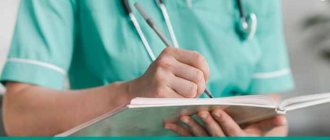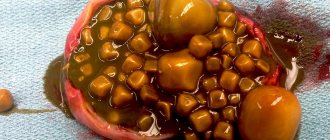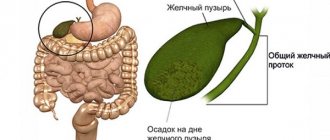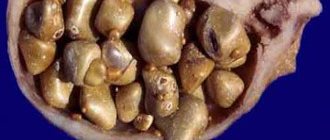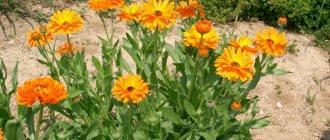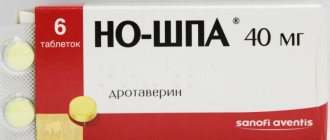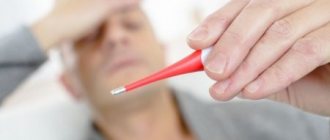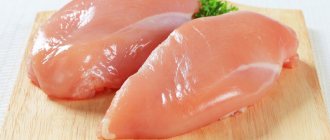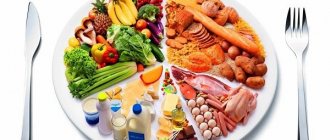Nutritional Features
A gentle diet has been developed for people with pathologies of the gallbladder, biliary tract and liver. It provides meals that are not low in calories, but limit the consumption of harmful foods.
The diet prescribes:
- eat 4 to 6 times a day;
- do not overeat;
- do not drink after meals, so as not to impair digestion;
- eat a lot of vegetables;
- do not mix different types of dishes at the same time;
- grind foods to facilitate the functioning of the gallbladder;
Therapeutic nutrition is prescribed for the following purposes:
- prevent digestive disorders;
- reduce cholesterol levels;
- eliminate fermentation processes in the intestines.
It is extremely important to limit your intake of foods rich in cholesterol.
General recommendations for the menu for stones in the gallbladder
In case of biliary disease, the total energy consumption per day should be 2400-2600 kilocalories. In this case, the volume of carbohydrates in the diet should be 280-320 grams, fats - preferably no more than 90 grams, and the same amount of proteins. The main factor in the development of exacerbations of cholelithiasis is the intake of food containing large amounts of fat, as well as fried foods.
In order to prevent the disease from worsening, the following rules should be followed:
- Under no circumstances allow yourself to overeat; you need to eat in small portions (up to five to seven times a day);
- The temperature of the food should be warm, since unsuitable temperature may trigger a functional problem of the gallbladder, such as gallbladder spasm;
- The amount of liquid you drink should be increased, but salt intake, on the contrary, should be reduced;
- Eliminate high-cholesterol foods from the diet; it is not allowed to take spices, essential oils, and, of course, foods prepared by frying;
- In our stores on the shelves there is a huge number of semi-finished products, which also should not be included in the menu;
- It is strictly forbidden to eat pickles, canned foods and foods containing a large number of acidifying agents.
A balanced diet that should be followed for gallstones should be based on boiled, stewed and oven-cooked foods (but without the so-called “crust”), as well as plant products and cereals (moderate in taste - neutral).
List of what not to eat
The list of what not to eat if you have gallstones is impressive. These prescriptions can also be applied to the diet of everyone who wants to prevent the development of pathologies of the gastrointestinal tract.
According to the above diet goals, a list of foods that should not be eaten if you have gallstone disease has been compiled:
- fatty parts of lamb and pork;
- sausages, sausages, frankfurters and similar products;
- smoked food;
- offal;
- dairy products not low-fat;
- peas (eat a little at a time);
- cauliflower;
- pickled products;
- alcohol;
- chocolate;
- halva;
- condensed milk;
- kozinaki;
- canned foods;
- fatty confectionery products;
- mineral water;
- carbonated drinks;
- ice cream;
- onion;
- dishes with mushrooms;
- spinach;
- spicy seasonings;
- radish;
- garlic;
- fruits with a significant acid content;
- radish;
- spices;
- fresh bread.
Ingestion of fatty foods often serves as a trigger for contractions of the gallbladder, causing pain after eating.
Gallstones
Prohibited Products
The treatment table for cholelithiasis excludes foods that contribute to the production of bile in large quantities (extractives, essential oils, purines), refractory fats, as they are difficult to digest and burden the liver and gall bladder, as well as foods rich in cholesterol.
You should not eat foods high in nitrogenous substances and oxalic acid, as they promote the formation of salts that precipitate and form stones in the gall bladder.
It is not recommended to include in your diet foods that irritate the digestive tract and cause gas formation and rotting in the intestines.
You should limit your intake of simple carbohydrates, which increase “bad cholesterol” levels, especially if you are overweight.
The list of prohibited products includes:
- fresh bread, rich pastries, white bread, fried donuts and pies, pancakes and pancakes, cakes;
- sharp and salty cheeses, high-fat cottage cheese, sour cream, cream, fermented baked milk, country milk;
- yolk and scrambled eggs (lots of cholesterol);
- animal fats, lard, margarine, cooking oil;
- rich meat and fish broths, mushroom soups, okroshka;
- mushrooms in any form;
- cereals: pearl barley, millet, barley;
- legumes, sorrel, white cabbage, Brussels sprouts, spinach;
- rhubarb, onions and garlic, radishes and radishes - a lot of essential oils and nitrogenous substances;
- fatty fish (salmon, sturgeon, eel, catfish), canned fish, smoked and salted fish;
- offal (liver, kidneys, tongue), canned meat, smoked meat, corned beef;
- sausages, frankfurters, small sausages;
- caviar, sushi;
- fast food;
- spicy and bitter herbs (dill, parsley, basil, thyme);
- spices: mustard, horseradish, mayonnaise, pepper, vinegar;
- almost all fruits and berries are raw, especially grapes, raspberries, cranberries, lingonberries;
- butter creams, ice cream, chocolate;
- drinks: cocoa, strong tea, coffee;
- fatty meats: pork, duck, goose.
What can you eat?
Diet during cholelithiasis should be closely monitored. A diet helps bring the patient’s health back to normal. You should be educated about what you can eat if you have gallstone disease.
The food is steamed or boiled, or occasionally baked. You can't eat fried food.
Allowed:
- soups containing vegetables, cereals, fruits. Mashed, not cooked in broth;
- casseroles including noodles, various cereals, cottage cheese;
- puddings;
- salads, stews and other dishes made from fruits and vegetables;
- souffle;
- pureed, semi-viscous porridge;
- protein-rich foods: boiled fish, veal, chicken;
- cabbage rolls;
- dumplings boiled with chicken and calf meat - a little at a time;
- vegetable oil;
- seafood - little by little;
- muesli;
- eggs (mostly whites), hard-boiled and in the form of omelettes;
- flax seeds;
- low fat dairy products;
- butter - moderate;
- unsalted cheese;
- rye and bran bread, as well as wheat bread, not fresh, slightly dried;
- crackers;
- fresh olives;
- pasta;
- wheat bran;
- dumplings (with potatoes, berries, cabbage);
- foods containing pectin: apples, beet pulp;
- leafy greens (unlimited): dill, cilantro, parsley, celery;
- jelly, compotes - from fruits and berries that do not contain much acid;
- non-spicy, low-fat sauces;
- biscuits;
- vanillin, cinnamon;
- marshmallows, marshmallows - limited;
- jam (not very sweet), jelly, marmalade;
- non-chocolate candies, lollipops;
- dried fruits;
- honey;
- sugar - limited;
- nougat;
- Turkish delight without nuts;
- dry biscuits;
- gingerbread without cocoa (infrequently);
Plant foods should make up a significant part of the diet.
Women are more likely to suffer from gallstone disease. Their diet has some peculiarities. Nutrition for gallstone disease in women takes into account the specifics of the menstrual cycle. Those who experience prolonged and heavy menstrual bleeding need to eat more veal. This meat contains a significant amount of iron, which serves to prevent iron deficiency in the body.
Overweight ladies need to focus on:
- turkey;
- chicken or chicken fillet;
- a rabbit.
Their meat is low in fat but rich in nutrients.
The following plants and substances are of interest in dietary nutrition.
Pumpkin
You can use pumpkin for cholelithiasis. The vitamins contained in the vegetable are useful for the course of biochemical processes in the liver. It is recommended to eat pumpkin when you are sick:
- boiled;
- baked;
- in the form of juice;
- raw.
Honey
Honey is widely used for gallstone disease. There are many recipes, but you should not prepare potions haphazardly. Types of honey affect the organs of the gastrointestinal tract in their own way, so you need to consult a doctor: an apitherapist or other specialist.
Oats
Oats are useful for gallstone disease. It is used in different forms:
- porridge;
- infusion: choleretic agent. You need to pour 1 glass of cereal with 1 liter of water, simmer until a quarter of the liquid evaporates. You should drink ½ glass in the morning, afternoon and before bed.
Turmeric
The issue of using turmeric spice in the diet for gallstone disease is controversial. It has a weak choleretic effect.
If you add plenty of turmeric to your food, a relapse of the disease is possible. It is recommended to use the seasoning in small doses and without exacerbation.
Rose hip
Prescribed for any liver pathologies. It is recommended to use rose hips for gallstone disease in the form of:
- infusion;
- powder;
- syrup;
- decoction
Medicines from the roots are also used.
Rosehip is included in the choleretic remedy “Holosas”.
The plant helps more effectively in combination with other herbs in collections.
Rosehip infusion
Beet
You can eat beets if you have gallstone disease. It improves metabolism. The vegetable contains betaine, which enhances choline production. The latter improves liver function. Prepared from beets:
- soups;
- salads;
- beet pulp;
- cutlets;
- juice.
For gallstone disease, it is useful to drink 1 glass of beetroot decoction daily.
Milk thistle
Milk thistle plant is recommended for use in case of cholelithiasis. Silymarin, its active ingredient:
- has an antioxidant effect;
- inhibits cholesterol synthesis in the liver;
- has anti-inflammatory properties.
Bananas
Bananas can be included in the menu for gallstone disease if a person does not experience discomfort from eating them.
In the acute period of the disease, these fruits are allowed to be eaten 1 per day.
Persimmon
Fans of persimmon with cholelithiasis should be careful.
If it is ripe and sweet, then you can eat it without an aggravation. You should not eat unripe persimmons - they can cause:
- stomach discomfort, irritation;
- nausea and vomiting;
- constipation.
Eggs
The diet does not prohibit eating eggs for gallstone disease, with restrictions.
The yolk is considered more harmful; it contains a significant amount of cholesterol. Protein is less saturated, but also not as nutritious. You can boil eggs hard. Omelettes with proteins are allowed, of which you can eat up to 2 per day. And the daily norm of yolk is up to one. Fried eggs are contraindicated in the diet.
What is allowed and what is prohibited during the diet
How to eat with cholelithiasis? Which foods are allowed and which are prohibited during a diet for gallstones can be seen from the table:
| Allowed foods on the diet | Prohibited foods on the diet |
| Beef, veal, rabbit, chicken and turkey | Meat, mushroom, fish broths and soups, jellied meat |
| Low-fat fish, preferably river fish - cod, pike, pike perch, carp, hake | Pork, goose or duck meat, lard By-products: kidneys, liver, tongue |
| Other seafood: shrimp, mussels, squid, kelp | Canned meat, fish, smoked marinades: fish and meat, pickles, sausages, frankfurters, ready-made semi-finished products (dumplings) |
| Durum wheat pasta dishes prepared without sauces | Sea fish: beluga, sturgeon, salmon, mackerel, catfish, stellate sturgeon |
| Porridges made from oats, buckwheat, rice, semolina, boiled in water | Cereals: barley, pearl barley, millet |
| Bread, slightly stale or in the form of crackers, of any variety, including white, baked pies filled with cottage cheese, apples, meat, fish from simple dough | Animal fats, margarine |
| Bran bread, dry biscuits | Vegetables with a high content of acids or essential oils: rhubarb, radish, sorrel, white cabbage, radishes, green onions, garlic, spinach |
| Vegetable decoctions | Egg yolks, hard-boiled or fried, quail eggs |
| Eggs (whites only) or “in a bag”, steam omelette | Fatty fermented milk products - cream, cottage cheese, fermented baked milk, sour cream, as well as full-fat milk and fatty cheeses |
| Low-fat fermented milk products (sour cream, cottage cheese, cheeses - Dutch, Russian), milk soups | Legumes (beans, peas) |
| Vegetables with a high content of pectin or starch: potatoes, tomatoes, pumpkin, cauliflower, zucchini, carrots, beets, green peas, tomatoes (in small quantities without exacerbation), sauerkraut, not very sour | Pastries from shortcrust and puff pastry, freshly baked bread, brown bread, pancakes, pastries, cakes |
| Butter, unrefined vegetable oil in small quantities, fish oil | Mustard, vinegar, mayonnaise, hot sauces, pepper, horseradish, ginger, soy sauce |
| Sweets: fruit mousses and jelly, marshmallows, marmalade, marshmallows, honey, nuts, seeds | Spicy herbs: basil, dill, coriander |
| Fruits: pomegranates, bananas, papaya, kiwi, sweet apples (preferably baked), watermelons, melon, strawberries, avocados, dried apricots | Chocolate, ice cream |
| Compotes and jelly from dried fruits, fresh berries, juices (diluted), especially carrot, tomato, beetroot, rosehip decoction, weak tea (especially green), alkaline mineral water | Fresh fruits and berries: raspberries, grapes, currants, gooseberries, cranberries, mangoes, cherry plums, all types of citrus fruits (oranges, tangerines, grapefruits, lemons), sour apples and plums, dates |
| Dill, parsley, bay leaf, vanillin, cinnamon, cloves | Coffee, chicory, strong tea, cocoa, carbonated drinks, kvass, flax seeds |
The diet for gallstones also takes into account the fact that in most cases patients have other concomitant diseases of the digestive system - gastritis, pancreatitis, and some foods can provoke fermentation and inflammation of the organ.
If it is not possible to give up broths and soups containing meat during a diet, then it is permissible to cook such dishes using lean meat and dilute them heavily with water or vegetable broth.
It is good to drink still mineral water allowed by the diet (Slavyanka) half an hour before meals. Coffee lovers who cannot give it up at all should at least reduce its concentration during the diet, drink it not on an empty stomach and with milk.
Drinking alcoholic beverages is strictly prohibited.
Sample menu
The menu for gallstone disease will be correctly drawn up, focusing on the list of permitted products that are as gentle as possible on the liver. A sample menu for those on a diet might look like this:
- breakfast: porridge cooked from oatmeal (mashed, slimy); steamed meatballs; not concentrated tea;
- 2nd breakfast: jelly, apple (soft, not sour);
- lunch: vegetable soup (with the addition of sunflower oil), lean meat roll, strawberry jelly;
- afternoon snack: rosehip drink, crackers;
- dinner: boiled potato cutlets, marshmallows, tea with lemon.
If you have gallstone disease, you cannot eat cold food!
Diet for gallstone disease during exacerbation
During an exacerbation of the disease, diet therapy must be followed in strict order - this will not only reduce the symptoms of the disease, but will also help to achieve remission faster.
During an attack of cholelithiasis, on the first day it is recommended to drink only herbal teas with the addition of rose hips and lemon balm. A small amount of liquid vegetable puree or broth is acceptable. Starting from the second day, during an exacerbation, you can gradually increase your diet, including more and more permitted foods in your diet. The main thing is to follow the basic rules indicated above. During the period when the disease has worsened, it is recommended to drink a mug of warm water or kefir at night to improve liver motility and gallbladder.
After an attack of gallstone disease, it is necessary to maintain nutrition with the right foods, since there is a risk of a new exacerbation. 7-10 days after the onset of an exacerbation, experts advise switching to special medical diet therapy - table No. 5.
Magnesium diet
There is a healthy diet of foods containing a lot of magnesium salts. The chemical element helps:
- relieve spasm and contract the gallbladder;
- improve intestinal motility;
- weaken the inflammatory process.
If you need to use a magnesium diet for gallstone disease, it is appropriate to use the following menu for 1 day:
- breakfast 1: buckwheat porridge (without butter), unsweetened tea (you can pour a little milk);
- breakfast 2: salad of grated fresh carrots, sweetened blackcurrant infusion;
- lunch: bread with added wheat bran, low-fat borscht, millet porridge with chopped dried apricots, rosehip drink;
- afternoon snack: half a glass of apricot juice, crackers;
- dinner: cottage cheese soufflé, weak tea;
- shortly before bedtime: rosehip infusion (100 ml).
When is diet number 5 prescribed?
Gallstone disease almost never manifests itself separately. Therefore, inflammation in the gallbladder is accompanied by other pathologies that affect the following organs:
- liver;
- stomach;
- intestines;
- pancreas;
- the cardiovascular system;
- nervous system.
Diet No. 5 is prescribed for the following diseases:
- Gallstone disease.
- Hepatitis.
- Gallstones.
What is included in this diet, what are its features and how it should be followed during an exacerbation of the disease, we will find out further.
Diet recommendations for gallstone disease
If you have gallstones or gallstones, you need to follow these rules in terms of nutrition:
- The energy value of the daily diet should be from 2 thousand to 2500 kcal, which is determined by the physiological characteristics of the body during this period.
- The amount of carbohydrates consumed should be in the range of 300−350, fats - about 90 g and proteins - 90 g, respectively. Remember that if there are stones in the gall bladder, the most serious provocateur of possible exacerbations is too fatty and fried foods.
- Avoid overeating.
- Products should not be hot or cold; consume everything warm.
- Practice split meals in small portions 6 times a day.
- Be sure to exclude refractory fats and stimulants of gastric and pancreatic secretion from your diet. These are spices, additives, foods high in cholesterol and with essential oils.
- The basis of nutrition is vegetables and fruits.
- Fried foods are strictly prohibited; steam, boil and sometimes bake foods.
Which fruits are ok and which are not for gallstone disease?
If you have gallstones and cholecystitis, you need to follow a diet that, although it allows you to eat fruit, is not all. With diet No. 5, you need to exclude the following acidic fruits and berries from your diet:
- citrus;
- gooseberry;
- sour apples;
- cranberries;
- plums and cherry plums;
- mango.
The following fruits are acceptable for gallstones:
- Bananas.
- Sweet apples;
- Melon.
- Watermelon.
- Avocado.
- Strawberry.
- Papaya.
But it’s better to cancel the grapes for now. The fact is that against the background of cholelithiasis and gallstones, the patient may experience diseases of the digestive system in the form of pancreatitis or gastritis. Therefore, you need to remove foods from your diet that can cause inflammation and fermentation of organs. These include grapes, black bread, kvass, cabbage and others.
Listen to yourself, if after this or that fruit you feel discomfort in your stomach, you need to either refuse it or reduce the dose of consumption.
What fruits can you eat?
When deciding what fruits you can eat if you have gallstone disease, you need to take into account their taste. The diet recommends eating sweet fruits:
- pears;
- bananas;
- persimmon;
- avocado;
- grenades;
- watermelons;
- papaya;
- pineapples;
- soft apples, better baked.
These fruits can be eaten little by little. If discomfort occurs, you should stop using. Dried fruits can be used for food both in dishes and on their own.
What drinks can you drink?
Some drinks with gallstone disease have a negative effect on health. Will not cause harm:
- not strongly brewed tea (it is allowed to add low-fat milk, sugar, lemon);
- juices squeezed from sweet fruits (diluted with water);
- jelly, fruit drinks (from non-acidic fruits);
- stevia drinks;
- compotes;
- chamomile tea;
- Slightly warmed cabbage juice is very useful;
- rosehip drink;
- fresh wild strawberry juice, infusion of its berries and leaves;
- low fat kefir;
- live yoghurts.
Coffee
Is it possible to drink coffee if you have gallstone disease? Many people ask this question. Unfortunately, the drink is harmful. It will have to be practically excluded from the diet.
Outside of an exacerbation, it is allowed to drink weakly brewed coffee, adding milk.
Alcohol
Alcohol is contraindicated for gallstone disease ! When drinking alcohol:
- there is a toxic effect, the load on the liver increases, the activity of which is already complicated due to the disease;
- the development of an inflammatory process in the pancreas is possible. This will make it difficult to treat gallstone disease.
Milk
You can drink milk if you have gallstone disease. It should not contain a lot of fat. Skim milk (separated from the creamy mass) is useful. Its fat content is 0.5% or less. It is good to add the product to tea and coffee.
Restrictions and prohibited foods after an attack
The diet after an attack of gallstone disease is prescribed to be as gentle as possible. The body that has experienced stress needs to return to normal.
Prohibited foods after an attack:
- fat;
- sour;
- smoked meats;
- fried;
- any canned food;
- spicy;
- meat on the first day of an attack;
- salt.
The diet for exacerbation of cholelithiasis prescribes frequent meals in small portions. This in itself helps to improve the patient's condition.
Diet features
When preparing a diet, take into account:
- biliary inflammation phase;
- weight and age;
- bowel regularity;
- background diseases, etc.
The chemical composition of the therapeutic nutrition system must be physiological, that is, correspond to the age, degree of physical activity, and gender of the patient.
For diseases of the gastrointestinal tract, food is taken often. If inflammation worsens, smoked and rich foods are completely removed from the menu.
During exacerbation of cholelithiasis
The diet for gallstone disease during an exacerbation involves avoiding fried foods. To improve your well-being you should:
- exclude meat dishes for 10 days;
- grind vegetables in a blender;
- eat only boiled or baked vegetables;
- do a drinking day every 7 days;
- take soups, low-fat sour milk, and vegetables as the basis of your diet.
This diet is followed for 2 weeks after an attack of gallstone disease. After stabilization of health, they move to table No. 5.
For inflammation of the gallbladder
A well-designed diet prevents bile from thickening. In case of relapse of the disease, it is advisable to:
- refuse food for 1-2 days;
- drink up to 2 liters of Narzan, Borjomi or other mineral water per day;
- after two days, add grated vegetables and fruits to the menu;
- eat food every 2 hours.
For non-calculous cholecystitis, you need to eat mucous oatmeal soups and porridge with rice. After the symptoms of the disease subside, the menu is expanded to include cottage cheese, beef, fish, and crackers.
After stone removal
The diet after crushing stones is aimed at stimulating bile drainage. The menu includes chemically neutral products that do not irritate the gastrointestinal tract, but improve the flow of bile.
After laparoscopy, the diet is followed for 6-10 months. Refusal of a rational nutrition system is dangerous due to complications.
Nutrition principles:
- energy value of the daily diet – 1800-2000 kcal;
- the ratio of proteins, lipids and carbohydrates is 1:1:4;
- the optimal heat treatment mode is cooking;
- the volume of one serving is no more than the size of a fist;
- the temperature of food consumed is up to 50°C.
For a week after the operation, food is taken pureed. Only from the fifth day is it allowed to eat meat dishes.
After removal of the gallbladder with stones
Cholecystectomy is a serious operation that affects the functions of the gastrointestinal tract. For a month, patients must follow a diet taking into account the following rules:
- Do not eat on the eve of cholecystectomy. You can drink up to 0.5 liters of water.
- The day after cholecystectomy, you are allowed to eat pureed vegetable soups. You can drink chamomile decoction or kefir.
- After 5 days, eat diet cutlets, meat rolls, chicken soufflé, and fish.
A week later, light foods are introduced into the diet - porridge, pureed soups, boiled vegetables.
Is fasting advisable?
Fasting for cholelithiasis is advisable at the time of exacerbation, no longer than a day. Drinking is allowed. Recommended drinks:
- water (up to 2.5 l);
- weak tea;
- fruit juice diluted with water.
In other cases, abstinence from food is not indicated: this contributes to the formation of new stones. During fasting, bile is not evacuated, it stagnates, and thickens. Sediment forms in it, from which new stones grow. In addition, its liquid part is absorbed through the walls of the gallbladder. This also causes the substance to thicken.
And after a long fast, eating food provokes increased contraction of the walls of the gallbladder, which can cause an attack of hepatic colic.
Reviews about drinking soda
Reviews of soda treatment for gallstone disease indicate that such treatment can seriously harm the body. This method cannot dissolve or reduce the size of gallstones.
Reviews from patients indicate negative results from using soda:
- exacerbation of cholecystitis with a temperature of 41°C;
- an increase in gallstones from 4-6 mm to 6-10 mm;
- after several years of daily use to suppress heartburn - emergency surgery for calculous (with stones) cholecystitis;
- as a result of long-term use, stomach acidity increased and gastritis was diagnosed;
- after systematic use - an attack of vomiting blood.
A constant artificial decrease in the acidity of the stomach with sodium bicarbonate disrupts its secretory function. This is associated with the appearance of a choleretic effect. They compensate for the weakening of the antimicrobial activity of gastric acid. Bile has the same disinfecting effect as the latter. Further stone formation occurs. This process is associated with an increase in the concentration of bile in the bladder. Heartburn appears and gastritis occurs, caused by excess production of acid in the stomach due to disorders of secretory function.
Soda cannot be recommended for the treatment of gallstone disease.
Recommended Products
Diet for gallstones should contain pectins and lipotropics. Products rich in pectins demonstrate an anti-inflammatory effect, cleanse the body of toxic substances, and help normalize intestinal microflora. And lipotropics thin the liver secretions, accelerate the breakdown of fats, and prevent the deposition of cholesterol plaques on the walls of blood vessels.
In addition, foods rich in magnesium are useful for cholelithiasis. They eliminate spasm of the biliary organs, eliminate inflammation, and normalize intestinal motility.
Patients are interested in the question of what products are useful for cholelithiasis. According to nutritionists, during treatment of pathology it is recommended to consume the following foods, dishes and drinks:
- Rye or bran bread, preferably stale.
- Galette cookies.
- Oatmeal, buckwheat, thick rice or semolina porridge with water or milk (half and half with water).
- Dishes from veal, rabbit, chicken, beef.
- Diet sausages.
- Lean fish.
- Wheat cuts, nuts, sunflower seeds, pumpkin.
- A little butter.
- Weak tea and alkaline mineral water (Essentuki, Borjomi) are used to dissolve small stones. In addition, it is recommended to drink pureed dried fruit compote, rosehip decoction, and freshly squeezed juices diluted with water.
- The patient should eat vegetables that contain pectins every day: beets, pumpkin, carrots. In addition, the diet needs to be replenished with foods rich in starch: potatoes, zucchini, paprika, cucumbers.
- Soups with vegetable broth, milk soup with noodles, fruit soup.
- Ripe bananas, baked apples, pomegranate. Fruits are allowed to be consumed only of sweet varieties and in minimal quantities.
- Fermented milk products with a low fat content. Such products contain vitamin D, which shifts the pH of bile to the alkaline side, preventing the formation of stones.
- Steamed protein omelette.
- Mild and low-fat cheese.
In addition, patients can sometimes indulge in jelly, marmalade, marshmallows, dried fruits, mousses, and jelly.
There are many recipes for delicious and healthy dishes made from permitted products, for example, potato soup, steamed cottage cheese soufflé, dietary risotto, vegetarian borscht, etc.
If the patient follows the rules of nutrition, then over time the biliary tract will work better, and overall health will improve.
Traditional healers strongly recommend drinking freshly squeezed juices from carrots, beets, spinach, cucumber, celery and other vegetables, as they dissolve stones. For the same purpose, infusions of celandine, wormwood, sweet clover, knotweed, smokeweed, etc. are used.
However, before using traditional recipes, you should consult a doctor. Otherwise, there is a risk of exacerbation of the disease, as well as the development of dangerous complications.
Cholelithiasis
The disease consists of the formation of stones in the gallbladder and ducts of the patient. They are formed from:
- cholesterol;
- bilirubin;
- mucus;
- inflammation products;
- calcium salts.
Provoke the occurrence of stones:
- binge eating;
- starvation;
- consumption of harmful foods;
- low physical activity, work in a sedentary position;
- obesity;
- stress;
- pregnancy;
- pathology of the pancreas.
The most characteristic manifestation of the disease is an attack of biliary colic.
This condition occurs in most cases when the stone moves through the ducts.
To prevent the development of the disease it is necessary:
- regular physical activity;
- healthy eating, diet;
- combating obesity;
- cure infectious and other diseases of the gastrointestinal tract;
- timely relief from bile stagnation;
- prevention of large psycho-emotional stress.
The importance of diet
Diet for gallstones is considered an important component of the treatment process. The diet must be followed both during periods of exacerbation and during periods of remission (which helps prolong the remission).
A special diet helps normalize the functions of the liver and gall bladder, stabilizes cholesterol levels, and normalizes the functioning of the digestive system. Vitamins and minerals present in the diet during the diet boost immunity and also help solve the problem of excess weight (help lose weight). Violation of the diet and non-compliance with the diet can sharply aggravate the disease.
Chronic cholecystitis of the gallbladder often occurs with concomitant pathological disorders in the stomach, pancreas, liver, intestines, with nervous and cardiovascular diseases, and corresponding symptoms arise. For the treatment of hepatitis, acute and chronic cholecystitis, gallstones, there is a special diet - “Table number 5”.
